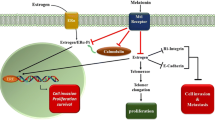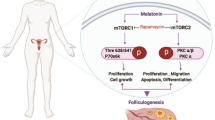Summary
TheN-methyl-N-nitrosurea (NMU) model of hormone-responsive rat mammary carcinogenesis was used to address the hypothesis that melatonin (Mel), the principle hormone of the pineal gland, inhibits tumorigenesis by acting as an anti-promoting rather than an anti-initiating agent. Daily late-afternoon injections of Mel (500 μg/day), restricted to the initiation phase of NMU mammary tumorigenesis, were ineffective in altering tumor growth over a 20-week period. When Mel treatment was delayed for 4 weeks after NMU and then continued through the remainder of the promotion phase, only tumor number was significantly lower than in controls. However, when Mel injections encompassed the entire promotion phase, both tumor incidence and number were significantly lower than in the controls. Although elimination of the endogenous Mel signal via pinealectomy promoted tumor growth, the effect was not statistically significant. Serum levels of estradiol and tumor estrogen receptor content were unaltered by either Mel or pinealectomy. While Mel treatment failed to affect circulating prolactin levels, pinealectomy caused a two-fold increase in serum prolactin. The estradiol-stimulated recrudescence of tumors following ovariectomy was completely blocked by either 20, 100 or 500 μg Mel/day or tamoxifen (20 μg/day). Thus, Mel appears to be an antipromoting hormone that may antagonize the tumor-promoting actions of estradiol in this model of mammary tumorigenesis.
Similar content being viewed by others
Abbreviations
- Mel:
-
melatonin
- NMU:
-
N-nitroso-N-methylurea
- E2 :
-
estradiol
- PRL:
-
prolactin
- ER:
-
estrogen receptor
- Tam:
-
tamoxifen
- DMBA:
-
7,12-dimethylbenzanthracene
References
Angerer E von, Knebel N, Kager M, Ganss B (1990) 1-(Ami-noalkyl)-2-phenylindoles as novel pure estrogen antagonists. J Med Chem 33:2635–2640
Arafah BM, Finegan HM, Roe J, Manni Pearson OH (1982) Hormone dependency inN-nitrosomethylurea-induced rat mammary tumors. Endocrinology 111:584–588
Aubert Ch, Janiaud P, Lecalvez J (1980) Effect of pinealectomy and melatonin on mammary tumor growth in Sprague-Dawley rats under different conditions of lighting. J Neural Transm 47:121–130
Bartsch C, Bartsch H, Lippert TH, Gupta D (1990) Effect of the mammary carcinogen 7,12-dimethylbenz(a)anthracene on pineal melatonin biosynthesis, secretion and peripheral metabolism. Neuroendocrinology 52:538–544
Blask DE, Hill SM (1986) Effects of melatonin on cancer: studies on MCF-7 human breast cancer cells in culture. J Neural Transm [Suppl] 21:433–449
Blask DE, Hill SM (1988a) Melatonin and cancer: basic and clinical aspects. In: Miles A, Philbrick DRS, Thompson C (eds) Melatonin-clinical perspectives. Oxford University Press, New York, pp 128–173
Blask DE, Hill SM, Pelletier DB (1988b) Oncostatic signaling by the pineal gland and melatonin in the control of breast cancer. In: Gupta D, Attanasio A, Reiter RJ (eds) The pineal gland and cancer. Brain Research Promotion, London pp 221–232
Blask DE, Hill SM, Orstead KM, Massa JS (1986) Inhibitory effects of the pineal hormone melatonin and underfeeding during the promotional phase of 7,12-dimethylbenzanthracene (DMBA)-induced mammary tumorigenesis. J Neural Transm 67:125–138
Boyns AR, Buchan R, Cole EN, Forrest APM, Griffiths K (1973) Basal prolactin blood levels in three strains of rat with differing incidence of 7,12-dimethylbenz(a)anthracene induced mammary tumors. Eur J Cancer 9:169–171
Bradford MM (1976) A rapid and sensitive method for the quantitation of microgram quantities of protein utilizing the principle of protein-dye binding. Anal Biochem 72:248–254
Burns DM, Cos Corral S, Blask DE (1990) Demonstration and partial characterization of 2-iodomelatonin binding sites in experimental mammary cancer. 72nd Annu Meet Endocrinol Soc, Abstr 151, p 62
Cardinali DP, Faigon MR, Scacchi P, Moguilevsky J (1979) Failure of melatonin to increase serum prolactin levels in ovariectomized rats subjected to superior cervical ganglionectomy or pinealectomy. J Endocrinol 82:315–319
Cos S, Blask DE, Lemus-Wilson A, Hill AB (1991) Effects of melatonin on the cell cycle kinetics and estrogen-rescue of MCF-7 human breast cancer cells in culture. J Pineal Res 10:36–42
Hamilton J (1969) Influence of environmental light and melatonin upon mammary tumor induction. Br J Surg 56:764–766
Hawkins RA, Drewitt D, Freedman B, Killin E, Jenner DA, Cameron EHO (1976) Plasma hormone levels and the incidence of carcinogen-induced mammary tumors in two strains. Br J Cancer 34:546–549
Hill SM (1986) Antiproliferative effect of the pineal hormone melatonin on human breast cancer cells in vitro. Doctoral Dissertation. University of Arizona, Tucson, USA
Hoffman RA, Reiter RJ (1965) Rapid pinealectomy in hamster and other small rodents. Anat Rec 153:19–22
Kerdelhue B, El Abed A (1979) Inhibition of preovulatory gonadotropin secretion and stimulation of prolactin secretion by 7,12-dimethylbenz(a)anthracene in Sprague-Dawley rats. Cancer Res 39:4700–4705
Kothari S, Shah PN, Mhatre ML (1984) Pineal ablation in varying photoperiods and the incidence of 9,10-dimethyl-1,2-benzan-thracene induced mammary cancer in rats. Cancer Lett 22:99–102
Kumar R, Sukumar S, Barbacid M (1990) Activation ofras oncogenes preceding the onset of neoplasia. Science 248:1101–1104
Lawson DM, Sensui N, Haisenleder DA, Kaufman PN, Gala RR (1984) Prolactin levels and molecular heterogeneity in rat strains with high and low incidence of DMBA-induced mammary tumors. Breast Cancer Res Treat 4:129–136
Leadem CA, Blask DE (1981) Evidence for an inhibitory influence of the pineal on prolactin in the female rat. Neuroendocrinology 33:268–275
Lemus-Wilson AM, Blask DE (1990) Inhibitory effect of melatonin on prolactin stimulated growth of MCF-7 breast cancer cells (abstract). J Cell Biol 111:479a
McGuire WL, DeLaGarza M (1973) Improved sensitivity in the measurement of estrogen receptor in human breast cancer. J Clin Endocrinol Metab 37:986–989
Reiter RJ (1980) The pineal and its hormones in the control of reproduction in mammals. Endocrinol Rev 1:109–131
Reiter RJ (1981) The mammalian pineal gland: structure and function. Am J Anat 162:287–313
Reiter RJ (1987) The melatonin message; duration versus coincidence hypothesis. Life Sci 46:2119–2131
Reiter RJ (1988) Pineal gland, cellular proliferation and neoplastic growth: an historical account. In: Gupta D, Attanasio A, Reiter RJ (eds) The pineal gland and cancer. Brain Research Promotion, London, pp 221–232
Rose DP, Noonan JJ (1982) Influence of prolactin and growth hormone on rat mammary tumors induced byN-nitrosomethylurea. Cancer Res 42:35–38
Ruddon RW (1987) Cancer Biology, 2nd edn, Oxford University Press, New York, pp 1–530
Shah PN, Mhatre MC, Kothari LS (1984) Effect of melatonin on mammary carcinogenesis in intact and pinealectomized rats in varying photoperiods. Cancer Res 44:3403–3407
Shull JD, Gorski J (1989) Estrogen regulation of prolactin gene transcription in vivo: paradoxical effects of 17-β-estradiol dose. Endocrinology 124:279–285
Swann PF (1968) The rate of breakdown of methyl methanesul-phonate, dimethyl sulphate andN-methyl-N-nitrosourea in the rat. Biochem J 110:49–52
Tamarkin L, Cohen M, Roselle D, Reichert C, Lippman M, Chabner B (1981) Melatonin inhibition and pinealectomy enhancement of 7,12-dimethylbenz(a)anthracene-induced mammary tumors in the rat. Cancer Res 41:4432–4436
Thompson DL Jr, Pickett BW, Nett TM (1978) Effect of season and artificial photoperiod on levels of estradiol 17-β and estrone in blood serum of stallions. J Anim Sci 47:184–187
Welsch CW (1985) Host factors affecting the growth of carcinogen-induced rat mammary carcinomas: a review and tribute to Charles Benton Huggins. Cancer Res 45:3415–3443
Welsch CW (1987) Rodent models to examine in vivo hormonal regulation of mammary gland tumorigenesis. In: Medina D, Kidwell W, Heppner G, Anderson F (eds) Cellular and molecular biology of mammary cancer. Plenum, New York, pp 163–179
Author information
Authors and Affiliations
Additional information
Supported by PHS grant CA-42424 from the NCI
Rights and permissions
About this article
Cite this article
Blask, D.E., Pelletier, D.B., Hill, S.M. et al. Pineal melatonin inhibition of tumor promotion in theN-nitroso-N-methylurea model of mammary carcinogenesis: potential involvement of antiestrogenic mechanisms in vivo. J Cancer Res Clin Oncol 117, 526–532 (1991). https://doi.org/10.1007/BF01613283
Received:
Accepted:
Issue Date:
DOI: https://doi.org/10.1007/BF01613283




